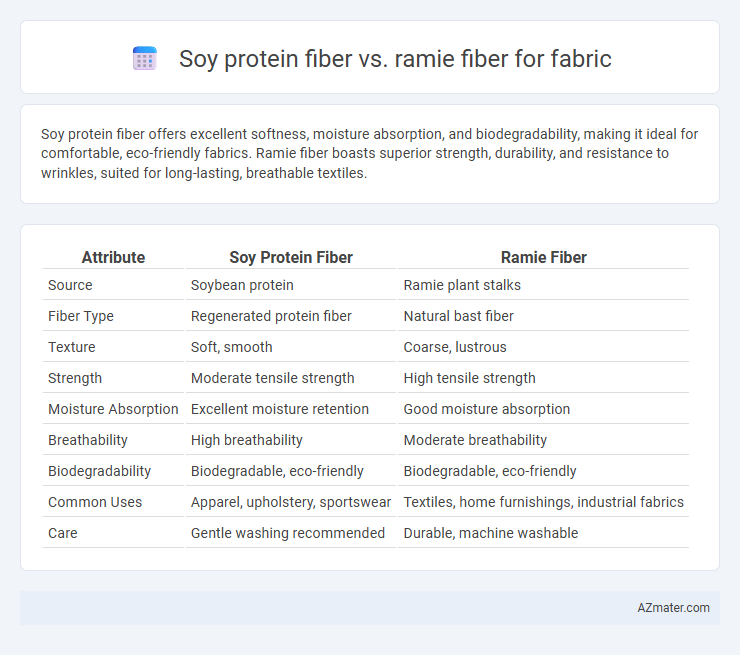Soy protein fiber offers excellent softness, moisture absorption, and biodegradability, making it ideal for comfortable, eco-friendly fabrics. Ramie fiber boasts superior strength, durability, and resistance to wrinkles, suited for long-lasting, breathable textiles.
Table of Comparison
| Attribute | Soy Protein Fiber | Ramie Fiber |
|---|---|---|
| Source | Soybean protein | Ramie plant stalks |
| Fiber Type | Regenerated protein fiber | Natural bast fiber |
| Texture | Soft, smooth | Coarse, lustrous |
| Strength | Moderate tensile strength | High tensile strength |
| Moisture Absorption | Excellent moisture retention | Good moisture absorption |
| Breathability | High breathability | Moderate breathability |
| Biodegradability | Biodegradable, eco-friendly | Biodegradable, eco-friendly |
| Common Uses | Apparel, upholstery, sportswear | Textiles, home furnishings, industrial fabrics |
| Care | Gentle washing recommended | Durable, machine washable |
Introduction to Soy Protein Fiber and Ramie Fiber
Soy protein fiber, derived from soybean protein, offers a sustainable and biodegradable alternative used in textile manufacturing due to its softness, moisture absorption, and hypoallergenic properties. Ramie fiber, extracted from the stalks of the Ramie plant (Boehmeria nivea), is known for its strength, durability, and natural luster, often blended with cotton to enhance fabric resilience. Both fibers contribute unique benefits in eco-friendly fabrics, with soy protein fiber emphasizing comfort and biodegradability, while Ramie fiber focuses on robustness and longevity.
Origin and Production Methods
Soy protein fiber originates from defatted soybean flakes through a process of fiber extrusion and spinning, emphasizing eco-friendly and renewable sources. Ramie fiber is derived from the stalks of the ramie plant, involving harvesting, retting, and degumming to extract strong, lustrous fibers. Production of soy protein fiber relies on biotechnological techniques to convert protein into semi-synthetic fiber, whereas ramie fiber processing depends on traditional mechanical and chemical methods.
Physical and Chemical Properties
Soy protein fiber exhibits excellent moisture absorption and elasticity, making it soft and comfortable for fabric use, while Ramie fiber is distinguished by its high tensile strength and stiffness due to its cellulose content. Chemically, soy protein fiber contains amino acid residues that contribute to its biodegradability and good dye affinity, whereas Ramie fiber, composed mainly of cellulose, offers superior resistance to microbial attack and chemical treatments. The physical smoothness and luster of Ramie fiber enhance fabric appearance, contrasting with the silk-like texture of soy protein fiber, which emphasizes comfort and stretchability.
Environmental Impact and Sustainability
Soy protein fiber offers a biodegradable and renewable alternative made from byproducts of soybean processing, significantly reducing agricultural waste and reliance on synthetic fibers. Ramie fiber, derived from the stalks of the Ramie plant, is highly sustainable due to its fast growth, low pesticide requirement, and carbon sequestration capabilities during cultivation. Both fibers promote eco-friendly fabric production, yet soy protein fiber stands out for its circular economy benefits, while Ramie excels in durability and minimal chemical inputs.
Durability and Strength Comparison
Soy protein fiber offers moderate durability and tensile strength, making it suitable for lightweight, breathable fabrics but less resilient under heavy wear. Ramie fiber exhibits superior strength and durability due to its natural lignin content, providing excellent resistance to stretching and tearing in textile applications. When comparing both, Ramie fiber outperforms soy protein fiber in overall fabric longevity and structural integrity, ideal for durable garments and industrial textiles.
Comfort and Sensory Experience
Soy protein fiber offers exceptional softness and a smooth texture, providing a luxurious and comfortable feel against the skin. Ramie fiber, known for its crispness and durability, delivers a cooler, slightly stiffer fabric that enhances breathability and moisture-wicking properties. While soy protein fiber excels in warmth retention and stretch, ramie provides a fresh sensory experience with its natural luster and ability to maintain shape in humid conditions.
Moisture Absorption and Breathability
Soy protein fiber exhibits superior moisture absorption compared to ramie fiber due to its protein-based structure, which can absorb and retain water more effectively, enhancing comfort in fabrics. Ramie fiber, derived from a natural cellulose source, offers excellent breathability by promoting air circulation through its hollow, fine filamentous structure, ideal for lightweight and cooling fabric applications. Combining soy protein fiber's moisture retention with ramie's breathability benefits results in fabrics that balance hydration management and ventilation for improved wearability.
Dyeability and Color Retention
Soy protein fiber exhibits superior dyeability compared to ramie fiber due to its protein-based structure, which allows it to absorb a wider range of dyes and achieve vibrant colors. Ramie fiber, being cellulose-based, has moderate dye affinity but often requires pre-treatment or mordants to enhance color uptake and retention. Soy protein fabrics generally maintain color better over time and through multiple washes, offering improved colorfastness relative to ramie fabrics.
Common Applications in Textiles
Soy protein fiber offers excellent moisture absorption and softness, making it ideal for next-to-skin garments such as underwear, sportswear, and baby clothing. Ramie fiber, known for its strength and durability, is commonly used in upholstery, home textiles, and blended fabrics for casual wear. Both fibers are eco-friendly alternatives, with soy protein favored in lightweight, breathable fabrics and ramie preferred for its wrinkle resistance and longevity in heavy-duty textile applications.
Cost and Market Availability
Soy protein fiber is generally more expensive than ramie fiber due to its innovative production process and limited large-scale manufacturing, affecting its market availability primarily in niche eco-friendly textile segments. Ramie fiber offers a more cost-effective option, benefiting from established cultivation and processing methods widely available in Asian markets, resulting in greater accessibility and consistent supply. Pricing strategies for fabrics often reflect ramie's affordability and durability, while soy protein fiber commands premium pricing attributed to its sustainability appeal and unique texture.

Infographic: Soy protein fiber vs Ramie fiber for Fabric
 azmater.com
azmater.com